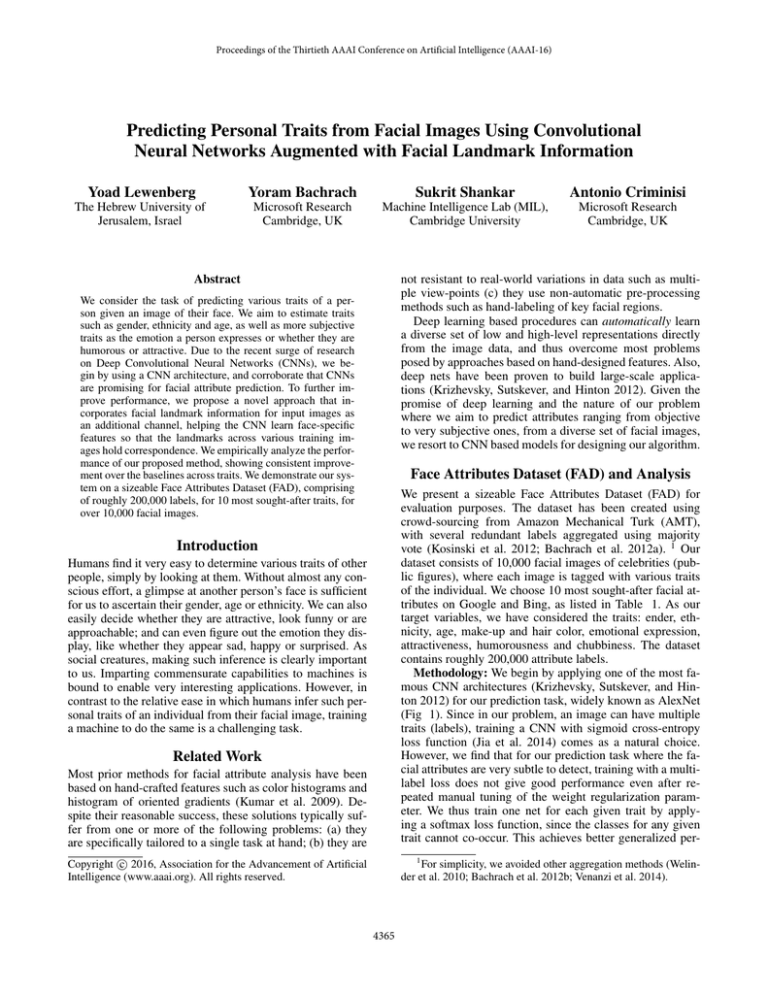
Proceedings of the Thirtieth AAAI Conference on Artificial Intelligence (AAAI-16)
Predicting Personal Traits from Facial Images Using Convolutional
Neural Networks Augmented with Facial Landmark Information
Yoad Lewenberg
Yoram Bachrach
Sukrit Shankar
Antonio Criminisi
The Hebrew University of
Jerusalem, Israel
Microsoft Research
Cambridge, UK
Machine Intelligence Lab (MIL),
Cambridge University
Microsoft Research
Cambridge, UK
not resistant to real-world variations in data such as multiple view-points (c) they use non-automatic pre-processing
methods such as hand-labeling of key facial regions.
Deep learning based procedures can automatically learn
a diverse set of low and high-level representations directly
from the image data, and thus overcome most problems
posed by approaches based on hand-designed features. Also,
deep nets have been proven to build large-scale applications (Krizhevsky, Sutskever, and Hinton 2012). Given the
promise of deep learning and the nature of our problem
where we aim to predict attributes ranging from objective
to very subjective ones, from a diverse set of facial images,
we resort to CNN based models for designing our algorithm.
Abstract
We consider the task of predicting various traits of a person given an image of their face. We aim to estimate traits
such as gender, ethnicity and age, as well as more subjective
traits as the emotion a person expresses or whether they are
humorous or attractive. Due to the recent surge of research
on Deep Convolutional Neural Networks (CNNs), we begin by using a CNN architecture, and corroborate that CNNs
are promising for facial attribute prediction. To further improve performance, we propose a novel approach that incorporates facial landmark information for input images as
an additional channel, helping the CNN learn face-specific
features so that the landmarks across various training images hold correspondence. We empirically analyze the performance of our proposed method, showing consistent improvement over the baselines across traits. We demonstrate our system on a sizeable Face Attributes Dataset (FAD), comprising
of roughly 200,000 labels, for 10 most sought-after traits, for
over 10,000 facial images.
Face Attributes Dataset (FAD) and Analysis
We present a sizeable Face Attributes Dataset (FAD) for
evaluation purposes. The dataset has been created using
crowd-sourcing from Amazon Mechanical Turk (AMT),
with several redundant labels aggregated using majority
vote (Kosinski et al. 2012; Bachrach et al. 2012a). 1 Our
dataset consists of 10,000 facial images of celebrities (public figures), where each image is tagged with various traits
of the individual. We choose 10 most sought-after facial attributes on Google and Bing, as listed in Table 1. As our
target variables, we have considered the traits: ender, ethnicity, age, make-up and hair color, emotional expression,
attractiveness, humorousness and chubbiness. The dataset
contains roughly 200,000 attribute labels.
Methodology: We begin by applying one of the most famous CNN architectures (Krizhevsky, Sutskever, and Hinton 2012) for our prediction task, widely known as AlexNet
(Fig 1). Since in our problem, an image can have multiple
traits (labels), training a CNN with sigmoid cross-entropy
loss function (Jia et al. 2014) comes as a natural choice.
However, we find that for our prediction task where the facial attributes are very subtle to detect, training with a multilabel loss does not give good performance even after repeated manual tuning of the weight regularization parameter. We thus train one net for each given trait by applying a softmax loss function, since the classes for any given
trait cannot co-occur. This achieves better generalized per-
Introduction
Humans find it very easy to determine various traits of other
people, simply by looking at them. Without almost any conscious effort, a glimpse at another person’s face is sufficient
for us to ascertain their gender, age or ethnicity. We can also
easily decide whether they are attractive, look funny or are
approachable; and can even figure out the emotion they display, like whether they appear sad, happy or surprised. As
social creatures, making such inference is clearly important
to us. Imparting commensurate capabilities to machines is
bound to enable very interesting applications. However, in
contrast to the relative ease in which humans infer such personal traits of an individual from their facial image, training
a machine to do the same is a challenging task.
Related Work
Most prior methods for facial attribute analysis have been
based on hand-crafted features such as color histograms and
histogram of oriented gradients (Kumar et al. 2009). Despite their reasonable success, these solutions typically suffer from one or more of the following problems: (a) they
are specifically tailored to a single task at hand; (b) they are
c 2016, Association for the Advancement of Artificial
Copyright Intelligence (www.aaai.org). All rights reserved.
1
For simplicity, we avoided other aggregation methods (Welinder et al. 2010; Bachrach et al. 2012b; Venanzi et al. 2014).
4365
Attribute 1
Landmark Augmentation
Create Rotated Images
Input Image
AlexNet
Attribute 2
AlexNet
Attribute 10
AlexNet
+ / - 20 degrees
+ / - 40 degrees
Figure 1: Illustration of our proposed Landmark Augmented CNN: Each input image is first data-supplemented, i.e. its four
rotated versions are created. Next, the RGB channels of all input images (including the additional rotated ones) are augmented
with one more channel which encodes the facial landmark information. The 4-channel input images are fed to AlexNets for
training, one for each trait. Landmark augmentation improves the prediction accuracy of facial attributes as shown in Table 1.
Trait
Gender (Male)
Ethnicity (White)
Hair Color (Dark)
Makeup
Age (Young)
Emotions (Joy)
Attractive
Humorous
Chubby
Data distribution
Y (0.51), N (0.49)
Y (0.79), N (0.21)
Y(0.60), N (0.40)
Y (0.39), N (0.61)
Y (0.68), N (0.32)
Y (0.64), N (0.36)
Y (0.66), N (0.34)
Y (0.56), N (0.44)
Y (0.57), N (0.43)
Baseline
98.46%
82.7%
91%
92.5%
88.42%
88.93%
78.44%
66.8%
60.6%
LACNN
98.33%
83.35%
91.69%
92.87%
88.83%
88.33%
78.85%
69.06%
61.38%
Experiments: We used FAD for all our experiments with
a 80/20 train/test split, evaluating our method on roughly
36,000 labels. For training and doing inference with CNNs,
we have used the Caffe Library (Jia et al. 2014). Table 1
shows the prediction accuracy of the baseline CNN method
and LACNN on FAD. It is clear that CNN provides an
overall impressive baseline performance, and the proposed
LACNN depicts consistent improvements over it. Note that
LACNN has the capability to improve performance for both
the objective as well as the subjective traits. This substantiates our intuition that face alignment information can prove
efficient in predicting facial attributes using deep nets.
Conclusions: We have proposed a method for predicting
personal attributes from facial images, based on a CNN architecture augmented with face alignment information. Experiments on a new dataset, called FAD, show consistent improvement across various traits with our method.
Table 1: Attributes / Traits in FAD and Comparison of Prediction Accuracy: Personal traits in FAD along with the
corresponding classes are listed (Y = Yes, N = No), along
the data class distribution. Some traits have more skewness across their classes as compared to others. LACNN improves the prediction accuracy as compared to the AlexNet
baseline for most traits.
References
Bachrach, Y.; Graepel, T.; Kasneci, G.; Kosinski, M.; and Van Gael,
J. 2012a. Crowd iq: aggregating opinions to boost performance. In
AAMAS.
Bachrach, Y.; Graepel, T.; Minka, T.; and Guiver, J. 2012b. How
to grade a test without knowing the answers—a bayesian graphical
model for adaptive crowdsourcing and aptitude testing. ICML.
Jia, Y.; Shelhamer, E.; Donahue, J.; Karayev, S.; Long, J.; Girshick,
R.; Guadarrama, S.; and Darrell, T. 2014. Caffe: Convolutional
architecture for fast feature embedding. In ICM, 675–678. ACM.
Kosinski, M.; Bachrach, Y.; Kasneci, G.; Van-Gael, J.; and Graepel,
T. 2012. Crowd iq: Measuring the intelligence of crowdsourcing
platforms. In ACM Web Sciences.
Krizhevsky, A.; Sutskever, I.; and Hinton, G. E. 2012. Imagenet
classification with deep convolutional neural networks. In NIPS,
1097–1105.
Kumar, N.; Berg, A. C.; Belhumeur, P. N.; and Nayar, S. K. 2009.
Attribute and Simile Classifiers for Face Verification. In ICCV.
Venanzi, M.; Guiver, J.; Kazai, G.; Kohli, P.; and Shokouhi, M.
2014. Community-based bayesian aggregation models for crowdsourcing. In WWW.
Welinder, P.; Branson, S.; Perona, P.; and Belongie, S. J. 2010. The
multidimensional wisdom of crowds. In NIPS.
Zhang, Z.; Luo, P.; Loy, C. C.; and Tang, X. 2014. Facial landmark
detection by deep multi-task learning. In ECCV.
formance, and hence, we establish our baseline and perform
all our experiments with this choice.
To account for pose variation, for each training image, we
create 4 new training images as its rotated versions. Each
training image is rotated by {−40, −20, 20, 40} degrees (Fig
1). Data augmentation is done both for baselines and our
proposed approach in order to draw a fair comparison.
Our proposed approach is based on incorporating facial
landmark information in the input data. Facial landmark localization algorithms are designed to find the location of several key “landmarks” in an image, such as the location of the
center of the eyes, parts of the nose or the sides of the mouth.
Consider a list L = (l1 , . . . , lk ) of facial landmarks. Facial
landmark localization algorithms receive a facial image I as
an input, and output the coordinates in the image for each of
the landmarks C I = (cI1 , . . . , cIk ) where cIj = (xIj , yjI ) are
the coordinates of landmark lj in the image I.
Our approach operates by associating each pixel in the
facial image with the closest facial landmark for that image.
We then add this association as an additional channel to each
input image. Since we use facial landmark localization algorithm just as a subroutine, so any such algorithm could be
used. In our experiments, we have used TCDCN (Zhang et
al. 2014) as the facial landmark detector.
4366







